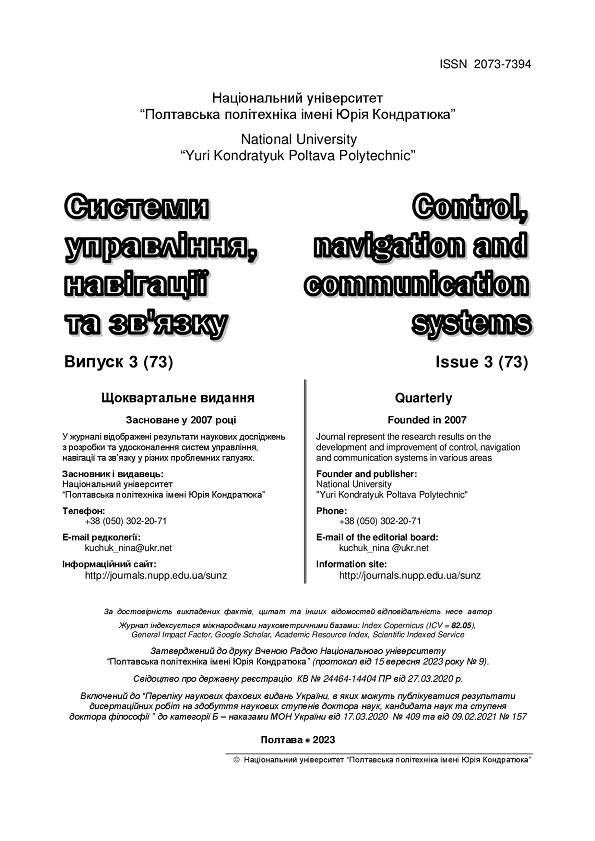DEVELOPMENT OF A MODEL OF A DEEP NEURAL NETWORK FOR ASSESSING THE STATE OF THE SEA ON THE BASIS OF THE SHIP'S MOTION
DOI:
https://doi.org/10.26906/SUNZ.2023.3.025Keywords:
deep neural network, network model, sea state estimation, vessel motion, tightly coupled convolutional neural networkAbstract
The aim of the work is to develop a deep neural network model for estimating the state of the sea based on the movement of a ship using densely connected convolutional neural networks to improve the safety and efficiency, accuracy, dependence, and dynamics of the sea state estimation for solving classification problems and regression problems. As a result of building a model of a deep neural network for assessing the state of the sea based on the movement of a vessel, the following results were obtained: initially, a network architecture was developed based on densely connected convolutional neural networks (Dense-Net) with a unique combination of modifications and layers. Such an architecture effectively considers the dependencies and dynamics of the vessel's movement, which leads to a more accurate assessment of the state of the sea; secondly, the network was trained on prepared vessel motion data using optimizers and loss functions selected in accordance with the task of assessing the state of the sea. The training process included tuning hyper parameters, optimizing weights, and evaluating model performance against test data; thirdly, the model was evaluated from the test data using appropriate metrics depending on the specific task of assessing the state of the sea. For example, the accuracy and error matrix were used for the classification task, and the mean absolute error (MAE) and root mean square error (MSE) were used for the regression task. The results of building a deep neural network model for estimating the state of the sea based on the movement of a vessel confirm its effectiveness and significance for research purposes. The application of such a model is important in the context of assessing the state of the sea. The high accuracy of the estimate helps to make more reliable decisions and predict possible changes in accordance with the sea conditions that are currently occurring in the movement of the vessel. Considering the dependencies and dynamics of the vessel's movement allows modeling and adapting to changing conditions, which increases its manufacturability and efficiency. The use of such a model helps to improve the safety and efficiency of offshore operations, optimize the use of resources, and prevent possible accidents. Thus, a deep neural network model developed to estimate the state of the sea based on the movement of a vessel is an effective tool for the safety and efficiency of navigation. Its use contributes to more accurate forecasts and informed decision-making, which is important for maritime operations and ensuring the safety of navigation in general.Downloads
References
Reiner, Carl, Detlefsen, Ole, and Moustafa Abdel-Maksoud. "On the Development of an Onboard Sea State Estimator Based on Numerical Vessel Motion Data." Paper presented at the The 32nd International Ocean and Polar Engineering Conference, Shanghai, China, June 2022. URL: https://onepetro.org/ISOPEIOPEC/proceedings-abstract/ISOPE22/All-ISOPE22/493898 (дата звернення: 28.04.2023).
X. Cheng, G. Li, R. Skulstad, H. Zhang and S. Chen, "SpectralSeaNet: Spectrogram and Convolutional Network-based Sea State Estimation," IECON 2020 The 46th Annual Conference of the IEEE Industrial Electronics Society, Singapore, 2020, pp. 5069-5074, doi: 10.1109/IECON43393.2020.9254890.
Umair, M.; Hashmani, M.A.; Hussain Rizvi, S.S.; Taib, H.; Abdullah, M.N.; Memon, M.M. A Novel Deep Learning Model for Sea State Classification Using Visual-Range Sea Images. Symmetry 2022, 14, 1487. https://doi.org/10.3390/sym14071487.
Ulrik D. Nielsen, Malte Mittendorf, Yanlin Shao, Gaute Storhaug, Wave spectrum estimation conditioned on machine learningbased output using the wave buoy analogy, Marine Structures, Volume 91, 2023,103470, ISSN 0951-8339, https://doi.org/10.1016/j.marstruc.2023.103470. (https://www.sciencedirect.com/science/article/pii/S095183392300103X).
Malte Mittendorf, Ulrik Dam Nielsen, Harry B. Bingham, Gaute Storhaug, Sea state identification using machine learning—A comparative study based on in-service data from a container vessel, Marine Structures, Volume 85, 2022, 103274, ISSN 0951-8339, https://doi.org/10.1016/j.marstruc.2022.103274.
Nielsen U. D. Sea state estimation based on measurements of wave-induced ship responses. – Technical University of Denmark, 2018.
Nielsen U. D. A concise account of techniques available for shipboard sea state estimation //Ocean Engineering. – 2017. – Т. 129. – С. 352-362.
Takekuma K. On the Evalution of Sea Spectra based on the Measured Ship Motions // Західна суднобудівна асоціація. – 1973. – №. 45. – С. 51-57.
Huang, G., Liu, Z., Van Der Maaten, L., & Weinberger, K. Q. (2017). Densely Connected Convolutional Networks. Proceedings of the IEEE Conference on Computer Vision and Pattern Recognition (CVPR).
X. Cheng, G. Li, A. L. Ellefsen, S. Chen, H. P. Hildre and H. Zhang, "A Novel Densely Connected Convolutional Neural Network for Sea-State Estimation Using Ship Motion Data," in IEEE Transactions on Instrumentation and Measurement, vol. 69, no. 9, pp. 5984-5993, Sept. 2020, doi: 10.1109/TIM.2020.2967115.
Lai, Zhichen, et al. "Multiscale wavelet-driven graph convolutional network for blade icing detection of wind turbines." IEEE Sensors Journal 22.22 (2022): 21974-21985.




